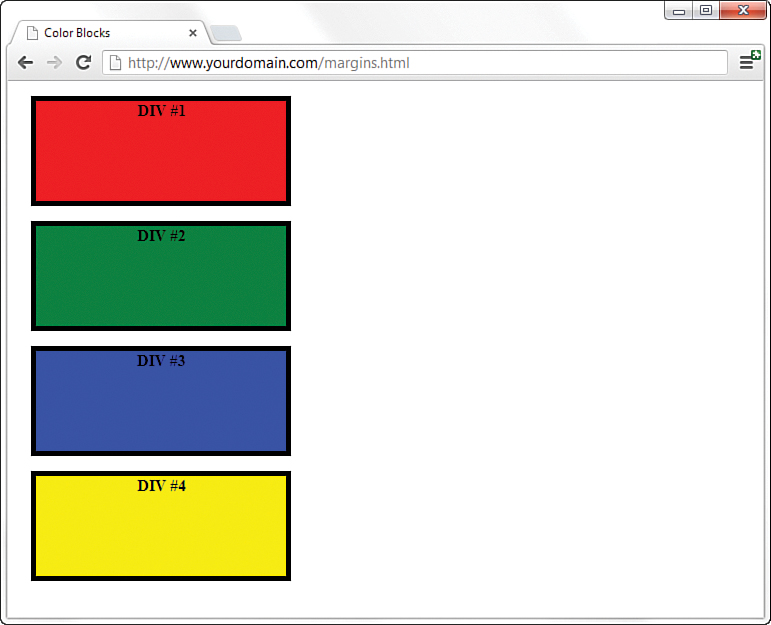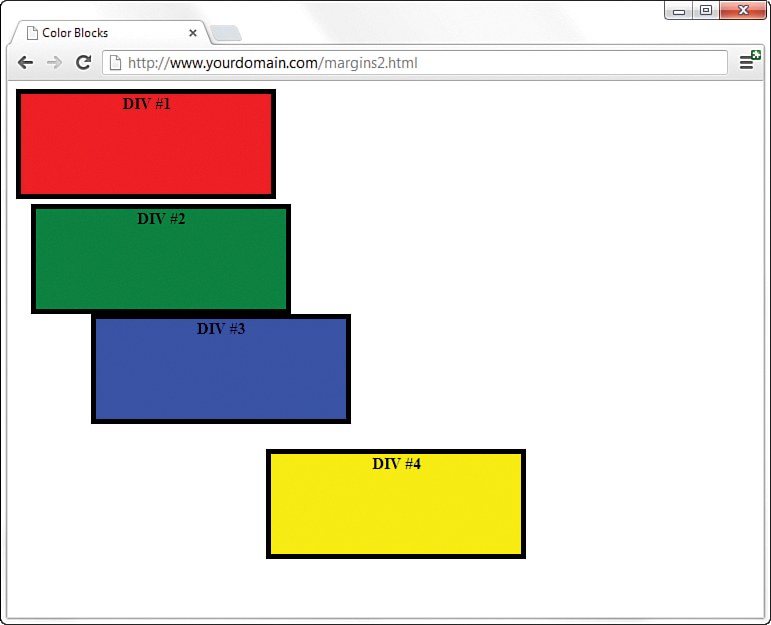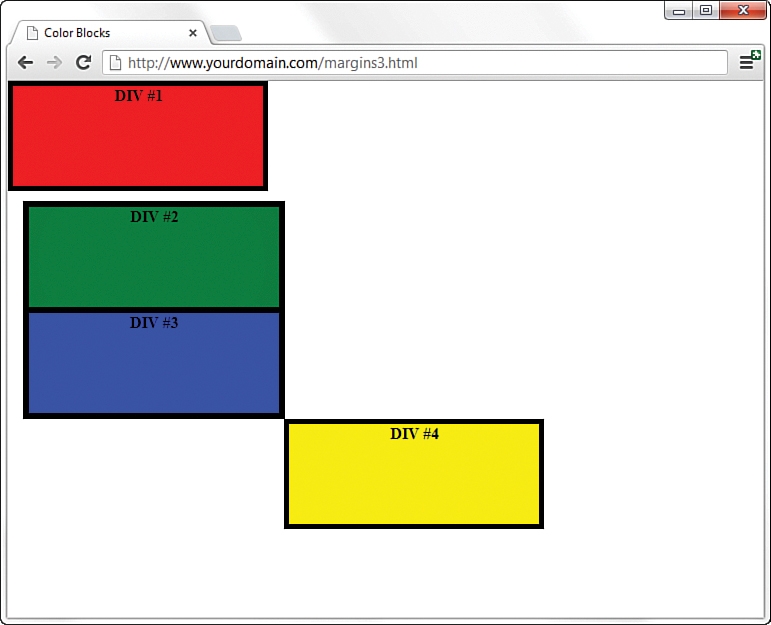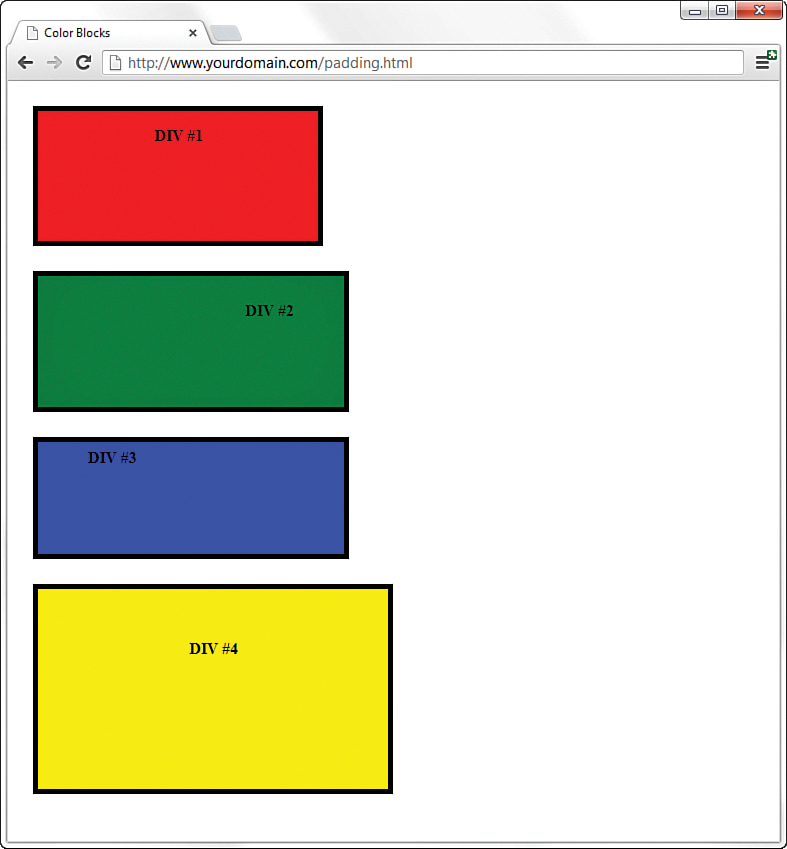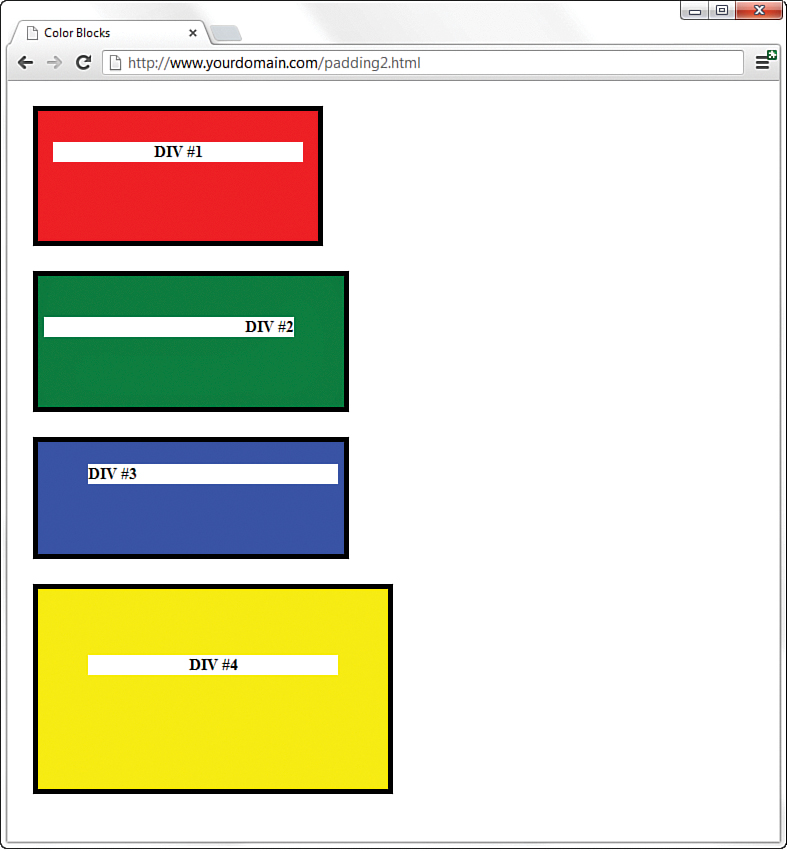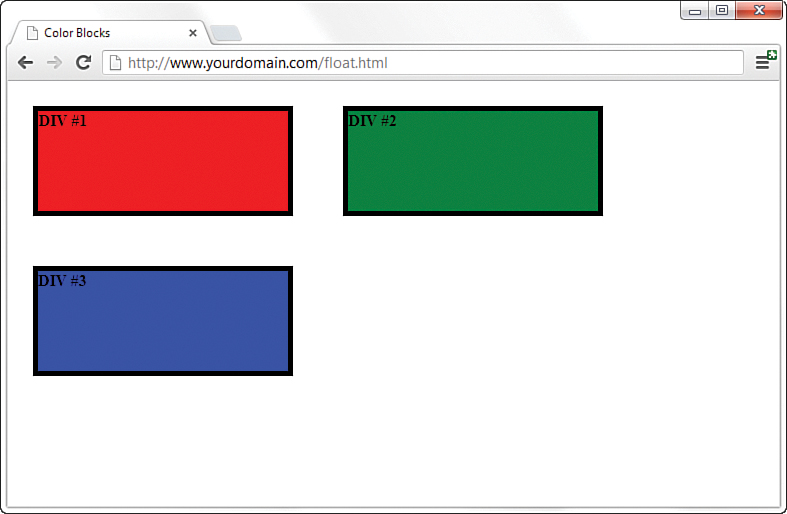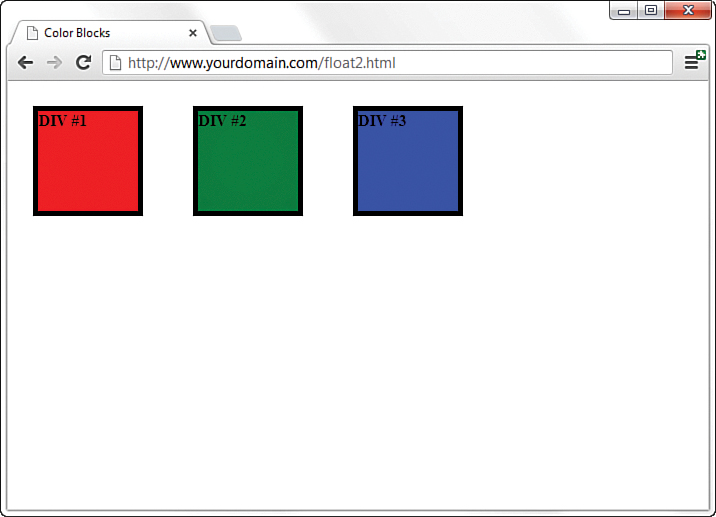Hour 13. Working with Margins, Padding, Alignment, and Floating
What You’ll Learn in This Hour:
![]() How to add margins around elements
How to add margins around elements
![]() How to add padding within elements
How to add padding within elements
![]() How to keep everything aligned
How to keep everything aligned
![]() How to use the
How to use the float property
Now that you’ve learned some of the basics of creating web content, in this hour, you learn the nitty-gritty of using CSS to enhance that content. In the hours that follow, you dive into using CSS to control aspects of your entire web page, not just individual pieces of text or graphics.
Before tackling page layout, however, it is important to understand four particular CSS properties individually before putting them all together:
![]() The
The margin and padding properties—For adding space around elements
![]() The
The align and float properties—To place your elements in relation to others
The examples provided in this hour are not the most stylish examples of web content ever created, but they are not intended to be. Instead, the examples clearly show just how HTML and CSS are working together. When you master CSS through this and other sections of the book, and through ongoing practice of what you’ve learned, you’ll be able to use your own design skills to enhance what can be (and often is) the relatively basic underlying scaffolding.
Using Margins
Stylesheet margins enable you to add empty space around the outside of the rectangular area for an element on a web page. It is important to remember that the margin property works with space outside the element.
Following are the style properties for setting margins:
![]()
margin-top—Sets the top margin
![]()
margin-right—Sets the right margin
![]()
margin-bottom—Sets the bottom margin
![]()
margin-left—Sets the left margin
![]()
margin—Sets the top, right, bottom, and left margins as a single property
You can specify margins using any of the individual margin properties or using the single margin property. Margins can be specified as auto, meaning that the browser itself sets the margin in specific lengths (pixels, points, or ems) or in percentages. If you decide to set a margin as a percentage, keep in mind that the percentage is calculated based on the size of the containing element. So if you set the margin-left property an element within the body to 25%, the left margin of the element will end up being 25% of the width of the entire page. However, if you set the margin-left property an element within that element to 25%, it will be 25% of whatever that original 25% was calculated to be.
Note
You can remember the shorthand order at least two different ways. First, if you think of an element as a rectangle, start at the top and work your way clockwise around the sides: top side, right side, bottom side, left side. Or you can use a first-letter mnemonic device and remember TRBL (pronounced “trouble” or “tribble,” if you’re a Star Trek fan), which also represents a possible state of being in case you forget the order of the margin properties.
Also note that the TRBL order is valid for padding properties and border properties as well.
The code in Listing 13.1 produces four rectangles on the page, each 250 pixels wide and 100 pixels high, with a 5-pixel solid black border (see Figure 9.2). Each rectangle—or <div>, in this case—has a different background color. We want the margin around each <div> to be 15 pixels on all sides, so we can use the following:
margin-top:15px;
margin-right:15px;
margin-bottom:15px;
margin-left:15px;
You can also write that in shorthand, using the margin property:
margin:15px 15px 15px 15px;
When you use the margin property (or padding or border) and you want all four values to be the same, you can simplify this even further and use this:
margin:15px;
When using shorthand for setting margins, padding, or borders, three approaches apply, which vary based on how many values you use when setting the property:
![]() One value—The size of all the margins
One value—The size of all the margins
![]() Two values—The size of the top/bottom margins and the left/right margins (in that order)
Two values—The size of the top/bottom margins and the left/right margins (in that order)
![]() Three values—The size of the top margin, the left and right margins (they are given the same value), and the bottom margin (in that order)
Three values—The size of the top margin, the left and right margins (they are given the same value), and the bottom margin (in that order)
![]() Four values—The size of the top, right, bottom, and left margins (in that order)
Four values—The size of the top, right, bottom, and left margins (in that order)
You might find it easier to stick to either using one value or using all four values, but that’s certainly not a requirement.
LISTING 13.1 Simple Code to Produce Four Colored <div>s with Borders and Margins
<!DOCTYPE html>
<html lang="en">
<head>
<title>Color Blocks</title>
<style type="text/css">
div {
width:250px;
height:100px;
border:5px solid #000000;
color:black;
font-weight:bold;
text-align:center;
}
div#d1 {
background-color:red;
margin:15px;
}
div#d2 {
background-color:green;
margin:15px;
}
div#d3 {
background-color:blue;
margin:15px;
}
div#d4 {
background-color:yellow;
margin:15px;
}
</style>
</head>
<body>
<div id="d1">DIV #1</div>
<div id="d2">DIV #2</div>
<div id="d3">DIV #3</div>
<div id="d4">DIV #4</div>
</body>
</html>
You can see the output of Listing 13.1 in Figure 13.1.
Next, working with just the margin property in the style sheet entries in Listing 13.1, let’s shift the margins. In this example, you can’t really see the right-side margin on any of these <div> elements because there’s nothing to the right of them and they’re not aligned to the right. With that in mind, let’s set margin-right to 0px in all of these. Beyond that, the next set of goals is to produce the following:
![]() No margin around the first color block
No margin around the first color block
![]() A left-side margin of 15 pixels, a top margin of 5 pixels, and no bottom margin around the second color block
A left-side margin of 15 pixels, a top margin of 5 pixels, and no bottom margin around the second color block
![]() A left-side margin of 75 pixels and no top margin or bottom margin around the third color block
A left-side margin of 75 pixels and no top margin or bottom margin around the third color block
![]() A left-side margin of 250 pixels and a top margin of 25 pixels around the fourth color block
A left-side margin of 250 pixels and a top margin of 25 pixels around the fourth color block
This seems like it would be straightforward—no margin is being set around the first block. But we want a margin at the top of the second block, so really there will be a visible margin between the first and second blocks, even if we are not specifying a margin for the first block.
The new stylesheet entries for the four named <div>s now look like this:
div#d1 {
background-color:red;
margin:0px;
}
div#d2 {
background-color:green;
margin:5px 0px 0px 15px;
}
div#d3 {
background-color:blue;
margin:0px 0px 0px 75px;
}
div#d4 {
background-color:yellow;
margin:25px 0px 0px 250px;
}
The result of the code changes (see Figure 13.2) seems random but is actually quite useful for pointing out a few other important points. For example, when you recall that one of the goals was to produce no margin around the first color block, you might expect the border of the color block to be flush with the browser window. But as Figure 13.2 shows, there is a clear space between the content of the page and the frame of the browser window.
If we were working on element placement—which we get to in the next hour—this would cause a problem in the layout. To ensure that your placements and margins are counted from a position flush with the browser, you need to address the margin of the <body> element itself. In this case, you add the following to your stylesheet:
body {
margin:0px;
}
Another “gotcha” to remember is that if you have two bordered elements stacked on top of each other, but with no margin between them, the point at which they touch appears to have a double border. You might then consider making the top element’s border-bottom half the width and then also make the bottom element’s border-top half the width. If you do this, the borders appear to be the same width as the other sides when stacked on top of each other.
In addition, you might have thought that using a left-side margin of 250 pixels—the width of the <div>s—would begin the fourth color block where the third color block ended. That is not the case, however, because the third color block has a margin-left of 75 pixels. For them to even be close to lining up, the margin-left value for the fourth div would have to be 325 pixels.
Changing the styles to those shown in the following code produces the spacing shown in Figure 13.3:
body {
margin:0px;
}
div {
width:250px;
height:100px;
color:black;
font-weight:bold;
text-align:center;
}
div#d1 {
border:5px solid #000000;
background-color:red;
margin:0px;
}
div#d2 {
border-width:6px 6px 3px 6px;
border-style:solid;
border-color:#000000;
background-color:green;
margin:10px 0px 0px 15px;
}
div#d3 {
border-width:3px 6px 6px 6px;
border-style:solid;
border-color:#000000;
background-color:blue;
margin:0px 0px 0px 15px;
}
div#d4 {
border:5px solid #000000;
background-color:yellow;
margin:0px 0px 0px 265px;
}

FIGURE 13.3 A third modification to the color blocks pulls items into closer relation with each other.
These changes give the <body> element a zero margin, thus ensuring that a margin-left value of 25 pixels truly is 25 pixels from the edge of the browser frame. It also shows the second and third color blocks stacked on top of each other, but with modifications to the border element so that a double border does not appear. Additionally, the fourth color block begins where the third color block ends.
As you can see in Figure 13.3, some overlap occurs between the right edge of the third color block and the left edge of the fourth color block. Why is that the case, if the color blocks are 250 pixels wide, the third color block has a margin-left value of 15 pixels, and the fourth color block is supposed to have a 265 pixel margin to its left? Well, it does have that 265 pixel margin, but that margin size is not enough because you also have to factor in the 6 pixels of border. Changing the margin property for the fourth color block to reflect the following code makes the third and fourth blocks line up according to plan (see Figure 13.4):
margin:0px 0px 0px 276px;
As shown in these examples, margin specifications are incredibly useful for element placement, but you must use caution when setting these specifications.
Padding Elements
Padding is similar to margins, in that it adds extra space to elements. The big difference is where that space is located. Recall that margins are added to the outside of elements. On the other hand, padding adds space inside the rectangular area of an element. As an example, if you create a style rule for an element that establishes a width of 50 pixels and a height of 30 pixels, and then sets the padding of the rule to 5 pixels, the remaining content area will be 40 pixels by 20 pixels. Also, because the padding of an element appears within the element’s content area, it assumes the same style as the content of the element, including the background color.
You specify the padding of a style rule using one of the padding properties, which work much like the margin properties. The following padding properties are available for use in setting the padding of style rules:
![]()
padding-top—Sets the top padding
![]()
padding-right—Sets the right padding
![]()
padding-bottom—Sets the bottom padding
![]()
padding-left—Sets the left padding
![]()
padding—Sets the top, right, bottom, and left padding as a single property
As with margins, you can set the padding of style rules using individual padding properties or the single padding property. You can also express padding using either a unit of measurement or a percentage.
Following is an example of how you might set the left and right padding for a style rule so that there are 10 pixels of padding on each side of an element’s content:
padding-left:10px;
padding-right:10px;
As with margins, you can set all the padding for an element with a single property (the padding property). To set the padding property, you can use the same three approaches available for the margin property. Following is an example of how you would set the vertical padding (top/bottom) to 12 pixels and the horizontal padding (left/right) to 8 pixels for a style rule:
padding:12px 8px;
Following is more explicit code that performs the same task by specifying all the padding values:
padding:12px 8px 12px 8px;
In all the previous figures, note that the text DIV #1, DIV #2, and so on appears at the top of the colored block, with just a little space between the border and the text. That amount of space hasn’t been specified by any padding value, but it appears as a sort of default within the element. If you want specific control over your element padding, Listing 13.2 shows some examples. All the color blocks are 250 pixels wide and 100 pixels high, have a 5-pixel solid black border, and have 25 pixels of margin (see Figure 13.5). The fun stuff happens within the padding values for each individual <div>.
LISTING 13.2 Simple Code to Produce Four Colored <div>s with Borders, Margins, and Padding
<!DOCTYPE html>
<html lang="en">
<head>
<title>Color Blocks</title>
<style type="text/css">
body {
margin:0px;
}
div {
width:250px;
height:100px;
border:5px solid #000000;
color:black;
font-weight:bold;
margin:25px;
}
div#d1 {
background-color:red;
text-align:center;
padding:15px;
}
div#d2 {
background-color:green;
text-align:right;
padding:25px 50px 6px 6px;
}
div#d3 {
background-color:blue;
text-align:left;
padding:6px 6px 6px 50px;
}
div#d4 {
background-color:yellow;
text-align:center;
padding:50px;
}
</style>
</head>
<body>
<div id="d1">DIV #1</div>
<div id="d2">DIV #2</div>
<div id="d3">DIV #3</div>
<div id="d4">DIV #4</div>
</body>
</html>
You should immediately recognize that something is amiss in this example. The color blocks are all supposed to be 250 pixels wide and 100 pixels high. The color blocks in Figure 13.5 are not uniform because, despite our efforts to control the size of the <div>, the padding applied later overrides that initial size declaration.
If you place the text in a <p> element and give that element a white background (see Figure 13.6), you can see where the padding is in relation to the text. When there just isn’t room to use all the padding that is defined, the surrounding element has to make adjustments. You will learn about this effect in detail in Hour 14, “Understanding the CSS Box Model and Positioning.”
The greatest number of tweaks or nudges you make in your web design with CSS will have to do with margins and padding. Just remember: Margins are outside the element; padding is inside it.
Keeping Everything Aligned
Knowing that content on a web page doesn’t always fill the entire width of the rectangular area in which it is displayed, it is often helpful to control the alignment of the content. Even if text within a rectangular area extends to multiple lines, alignment enters the picture because you might want the text left-justified, right-justified, or centered. Two style properties enable you to control the alignment of elements: text-align and vertical-align.
You saw examples of these style properties in action (when aligning images) in Hour 11, but it doesn’t hurt to mention these properties again here because alignment plays a role in overall page design as well.
As a refresher, using text-align aligns an element horizontally within its bounding area, and it can be set to left, right, center, or justify.
The vertical-align property is similar to text-align except that it is used to align elements vertically. The vertical-align property specifies how an element is aligned with its parent or, in some cases, the current line of elements on the page. “Current line” refers to the vertical placement of elements that appear within the same parent element—in other words, inline elements. If several inline elements appear on the same line, you can set their vertical alignments the same to align them vertically. A good example is a row of images that appear one after the next—the vertical-align property enables you to align them vertically.
Following are common values for use with the vertical-align property:
![]()
top—Aligns the top of an element with the current line
![]()
middle—Aligns the middle of an element with the middle of its parent
![]()
bottom—Aligns the bottom of an element with the current line
![]()
text-top—Aligns the top of an element with the top of its parent
![]()
baseline—Aligns the baseline of an element with the baseline of its parent
![]()
text-bottom—Aligns the bottom of an element with the bottom of its parent
Alignment works in conjunction with margins, padding, and (as you learn in the next section) the float property to enable you to maintain control over your design.
Understanding the Float Property
Understanding the float property is fundamental to understanding CSS-based layout and design; it is one of the last pieces in the puzzle of how all these elements fit together. Briefly stated, the float property allows elements to be moved around in the design so that other elements can wrap around them. You often find float used in conjunction with images (as you saw in Hour 11), but you can—and many designers do—float all sorts of elements in their layout.
Elements float horizontally, not vertically, so all you have to concern yourself with are two possible values: right and left. When used, an element that floats will float as far right or as far left (depending on the value of float) as the containing element will allow it. For example, if you have three <div>s float values of left, they will all line up to the left of the containing body element. If you have your <div>s within another <div>, they will line up to the left of that element, even if that element itself is floated to the right.
Floating is best understood by seeing a few examples, so let’s move on to Listing 13.3. This listing simply defines three rectangular <div>s and floats them next to each other (floating to the left).
LISTING 13.3 Using float to Place <div>s
<!DOCTYPE html>
<html lang="en">
<head>
<title>Color Blocks</title>
<style type="text/css">
body {
margin:0px;
}
div {
width:250px;
height:100px;
border:5px solid #000000;
color:black;
font-weight:bold;
margin:25px;
}
div#d1 {
background-color:red;
float:left;
}
div#d2 {
background-color:green;
float:left;
}
div#d3 {
background-color:blue;
float:left;
}
</style>
</head>
<body>
<div id="d1">DIV #1</div>
<div id="d2">DIV #2</div>
<div id="d3">DIV #3</div>
</body>
</html>
Figure 13.7 shows the resulting page. Already you can see a problem—these three color blocks were supposed to be floated next to each other. Well, actually they are floated next to each other, but the browser window is not wide enough to display these three 250-pixel-wide blocks with 25 pixels of margin between them. Because they are floating, the third one simply floats to the next line.
You can imagine that this could be a problem in a specifically designed visual layout, so pay attention to your margins, padding, alignment, and floating while also testing within a target browser window size. Granted, the browser window in Figure 13.7 is a small one to make this point about floating elements moving to the next line when there is no room for them to fit where they should. In other words, if you open the same HTML file with a larger browser window, you might not see the issue—this is why you should also check your sites at different resolutions to see if a fix is needed. The fix here is to adjust the margins and other size-related properties of your <div>s.
Figure 13.8 shows another interesting possibility when using the float property. The only changes made to the code from Listing 13.3 involved making the color blocks only 100-pixels wide, reducing the margins to 10px, and changing the float alignment of the second color block to right (instead of left).
However, something interesting happened. The second color block now appears visually as the third color block because it is flush right. The second color block has a float value of right, so it has floated all the way to the right. The first and third color blocks are floating as left as possible, regardless of the way in which the <div> code appears in the HTML, which is as follows:
<div id="d1">DIV #1</div>
<div id="d2">DIV #2</div>
<div id="d3">DIV #3</div>
Floating takes a lot of practice to get used to, especially when your page has additional elements in your page, not just a few colored blocks. For example, what happens when you add a basic paragraph to the mix? All elements placed after the floating element then float around that element. To avoid that, use the clear property.
The clear property has five possible values: left, right, both, none, and inherit. The most common values are left, right, and both. Specifying clear:left ensures that no other floating elements are allowed to the left, clear:right ensures that no other floating elements are allowed to the right, and so on. Floating and clearing is a learn-by-doing process, so look for more situations in the Workshop at the end of this hour.
Summary
This hour introduced you to some of the most fundamental style properties in CSS-based design: margin, padding, and float. You learned how the margin property controls space around the outside of elements and how the padding property works with space within the elements.
After a refresher on the text-align and vertical-align properties you learned about in a previous hour, you learned about the float property. The float property allows for specific placement of elements and additional content around those elements.
Q&A
Q. The examples of margins and padding all had to do with boxes and text. Can I apply margins and padding to images as well?
A. Yes, you can apply margins and padding to any block-level element, such as a <p>, a <div>, an <img/>, and lists such as <ul> and <ol>, as well as list items (<li>)—just to name a few.
Workshop
The Workshop contains quiz questions and exercises to help you solidify your understanding of the material covered. Try to answer all questions before looking at the “Answers” section that follows.
Quiz
1. To place two <div> elements next to each other, but with a 30-pixel margin between them, what entry or entries can you use in the stylesheet?
2. Which CSS style property and value is used to ensure that content does not appear to the left of a floating element?
3. What stylesheet entry is used to place text within a <div> to appear 12 pixels from the top of the element?
Answers
1. You can use several entries. The first <div> uses a style property of margin-right:15px. The second <div> uses a style property of margin-left:15px. Or you can assign the full 30 pixels to either <div> using margin-right or margin-left, as appropriate. Additionally, at least the first <div> needs to have float:left assigned to it.
2. In this instance, use clear:left.
3. padding-top:12px
Exercises
![]() Fully understanding margins, padding, alignment, and floating takes practice. Using the color blocks code or
Fully understanding margins, padding, alignment, and floating takes practice. Using the color blocks code or <div>s of your own, practice all manner and sorts of spacing and floating before moving on to the next hour. The next hour discusses the CSS box model as a whole, which encompasses the individual items discussed in this hour.
![]() While you’re at it, practice applying margins and padding to every block-level element you’ve learned so far. Get used to putting images within blocks of text and putting margins around the images so that the text does not run right up to the edge of the graphic.
While you’re at it, practice applying margins and padding to every block-level element you’ve learned so far. Get used to putting images within blocks of text and putting margins around the images so that the text does not run right up to the edge of the graphic.

